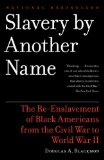Summary | Excerpt | Reviews | Readalikes | Genres & Themes | Author Bio
The Re-Enslavement of Black Americans from the Civil War to World War II

Critics' Opinion:
Readers' Opinion:
First Published:
Mar 2008, 480 pages
Paperback:
Jan 2009, 496 pages
Elisha had arrived at the banks of the Cahaba, barely a man himself, in an Alabama territory that was still untamed. It was 1817, and Elisha and his three brothers faced a dense wilderness governed by the uncertainties of Indian territory and the vagaries of an American nation debating the precepts of eminent domain that would ultimately expand its borders from the Atlantic to the Pacific Ocean.1 Alabama would not be a state for two more years.
Elisha’s brother Charles soon decamped to the newly founded county seat of Centreville, where in short order shallow-draft riverboats would land and a trading center would be established.2 Another brother, William, moved farther south. But Elisha and his younger sibling, John, stayed in the wilderness on the Cahaba. In the four decades before the Civil War, they staked out land, brought in wives, cleared the lush woodlands, sired bountiful families, and planted season upon season of cotton. The engines of their enterprises were black slaves. In the early years, they imported them to Alabama and later bred more themselves—including Henry—from the African stock they bought at auction or from peripatetic slave peddlers who arrived unbidden in springtime with traces of ragged, shackled black men and women, carrying signs advertising “Negroes for Sale.” Manning farms strung along a looping wagon road, the brothers and their slaves cleared the land, raised cabins, and built the church where they would pray. Harnessing their black labor to the rich black land, the Cottingham brothers became prosperous and comfortable.
Some neighbors called the Cottingham section of the county Pratt’s Ferry, for the man who lived on the other side of the Cahaba and poled a raft across the water for a few pennies a ride. But the Cottinghams, God-fearing people who gathered a congregation of Methodists in the wilderness almost as soon as they had felled the first timber, adopted for their homestead a name marking the work not of man but of the Almighty. Where the clear cold creek gurgled into the Cahaba, a massive bulge of limestone rose from the water, imposing itself over a wide, sweeping curve in the river. To the Cottinghams, this place was Riverbend.
The Cottinghams demanded a harsh life of labor from their bondsmen. Otherwise, what point was there to the tremendous investment required of owning slaves. Yet, especially in contrast to the industrial slavery that would eventually bud nearby, life on the Cottingham plantation reflected the biblical understanding that cruelty to any creature was a sin—that black slaves, even if not quite men, were at least thinly made in the image of God.
Set among more than twenty barns and other farm buildings, Henry and the rest of the slaves lived in crude but warm cabins built of rough-hewn logs chinked with mud. Heat came from rock fireplaces with chimneys made of sticks and mud. Elisha recorded the ownership of thirteen slaves in 1860, including four men in their twenties and thirties and six other male teenagers. A single twenty-year-old female lived among the slaves, along with two young boys and a seven-year-old girl.
Given the traditions of isolated rural farms, Elisha’s grandson Oliver, raised there on the Cottingham farm, would have been a lifelong playmate of the slave boy nearly his same age, named Henry.4 When Elisha Cottingham’s daughter Rebecca married a neighbor, Benjamin Battle, in 1852, Elisha presented to her as a wedding gift the slave girl who likely had been her companion and servant. “In consideration of the natural love and affection which I bear to my daughter,” Elisha wrote, I give her “a certain negro girl named Frances, about 14 years old.”
Those slaves who died on the Cottingham place were buried with neat ceremony in plots marked by rough unlabeled stones just a few feet from where Elisha himself would be laid to rest in 1870—clearly acknowledged as members in some manner of a larger human family recognized by the master. Indeed, Elisha buried his slaves nearer to him by far than he did Rev. Starr, the man who ministered to all of the souls on the Cottingham place. The Starr family plot, with its evangelical inscriptions and sad roster of infant dead, was set down the hill and toward the road, even more vulnerable to the creeping oblivion of time.
Excerpted from Slavery By Another Name by Douglas A. Blackmon Copyright © 2009 by Douglas A. Blackmon. Excerpted by permission of Anchor, a division of Random House, Inc. All rights reserved. No part of this excerpt may be reproduced or reprinted without permission in writing from the publisher.





The Flower Sisters
by Michelle Collins Anderson
From the new Fannie Flagg of the Ozarks, a richly-woven story of family, forgiveness, and reinvention.

The House on Biscayne Bay
by Chanel Cleeton
As death stalks a gothic mansion in Miami, the lives of two women intertwine as the past and present collide.

The Funeral Cryer by Wenyan Lu
Debut novelist Wenyan Lu brings us this witty yet profound story about one woman's midlife reawakening in contemporary rural China.
Your guide toexceptional books
BookBrowse seeks out and recommends the best in contemporary fiction and nonfiction—books that not only engage and entertain but also deepen our understanding of ourselves and the world around us.